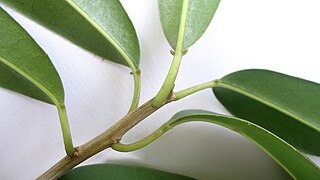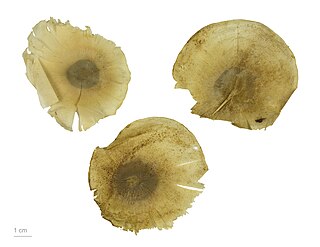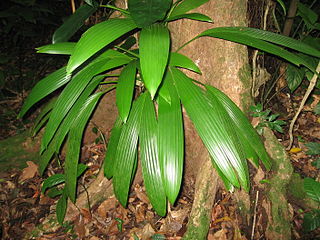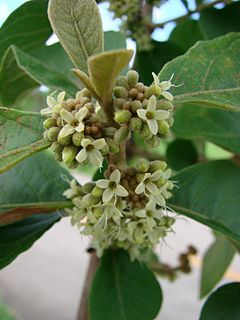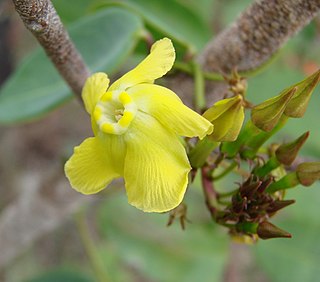| Sphaeradenia | |
|---|---|
 | |
| Sphaeradenia laucheana [1] | |
| Scientific classification | |
| Kingdom: | Plantae |
| Clade: | Angiosperms |
| Clade: | Monocots |
| Order: | Pandanales |
| Family: | Cyclanthaceae |
| Genus: | Sphaeradenia Harling |
| Synonyms [2] | |
| |
Sphaeradenia is a genus of plant in family Cyclanthaceae, first described as a genus in 1954. It is native to Central America and South America. [2]

Plants are mainly multicellular, predominantly photosynthetic eukaryotes of the kingdom Plantae. Historically, plants were treated as one of two kingdoms including all living things that were not animals, and all algae and fungi were treated as plants. However, all current definitions of Plantae exclude the fungi and some algae, as well as the prokaryotes. By one definition, plants form the clade Viridiplantae, a group that includes the flowering plants, conifers and other gymnosperms, ferns and their allies, hornworts, liverworts, mosses and the green algae, but excludes the red and brown algae.

Cyclanthaceae is a family of flowering plants.

Central America is a region found in the southern tip of North America and is sometimes defined as a subcontinent of the Americas. This region is bordered by Mexico to the north, Colombia to the southeast, the Caribbean Sea to the east and the Pacific Ocean to the west and south. Central America consists of seven countries: Belize, Costa Rica, El Salvador, Guatemala, Honduras, Nicaragua and Panama. The combined population of Central America is estimated to be between 41,739,000 and 42,688,190.
- Species [2]
- Sphaeradenia acutitepala - from Nicaragua to Colombia
- Sphaeradenia alba - Panama
- Sphaeradenia alleniana - Costa Rica, Panama
- Sphaeradenia amazonica - Colombia, Venezuela, NW Brazil
- Sphaeradenia angustifolia - Peru
- Sphaeradenia asplundii - Ecuador
- Sphaeradenia brachiolata - Ecuador
- Sphaeradenia buenaventurae - Colombia
- Sphaeradenia carnosa - Colombia
- Sphaeradenia chiriquensis - Costa Rica, Panama
- Sphaeradenia columnaris - Colombia
- Sphaeradenia compacta - Colombia
- Sphaeradenia crassiceps - Peru
- Sphaeradenia crocea - Costa Rica, Panama, Colombia
- Sphaeradenia cuatrecasana - Colombia
- Sphaeradenia danielii - Colombia
- Sphaeradenia distans - Colombia
- Sphaeradenia duidae - Venezuela, NW Brazil
- Sphaeradenia fosbergii - Colombia
- Sphaeradenia garciae - Costa Rica, Panama, Colombia, Ecuador
- Sphaeradenia gigantea - Colombia
- Sphaeradenia hamata - Colombia, Ecuador
- Sphaeradenia horrida - Colombia, Ecuador
- Sphaeradenia killipii - Colombia, Ecuador
- Sphaeradenia laucheana - from Costa Rica to Peru
- Sphaeradenia lemaensis - Bolívar in Venezuela
- Sphaeradenia magniglobula - Costa Rica, Panama
- Sphaeradenia marcescens - Ecuador
- Sphaeradenia meridionalis - Peru, Bolivia
- Sphaeradenia occidentalis - Costa Rica
- Sphaeradenia oligostemon - Colombia
- Sphaeradenia oxystigma - Ecuador, Peru
- Sphaeradenia pachystigma - Costa Rica, Panama
- Sphaeradenia pallida - Colombia
- Sphaeradenia perangusta - Amazonas in Peru
- Sphaeradenia praetermissa - Costa Rica
- Sphaeradenia proboscidifera - Colombia
- Sphaeradenia pterostigma - Colombia, Ecuador
- Sphaeradenia pulchra - Colombia
- Sphaeradenia purpurea - Colombia
- Sphaeradenia rhodocephala - Ecuador, Peru
- Sphaeradenia rostellata - Costa Rica
- Sphaeradenia sanctae-barbarae - Ecuador
- Sphaeradenia scandens - Colombia
- Sphaeradenia sphagnicola - Costa Rica
- Sphaeradenia stenosperma - Colombia
- Sphaeradenia steyermarkii - Colombia, Ecuador, Peru
- Sphaeradenia stylosa - Colombia, Ecuador, Peru
- Sphaeradenia vallensis - Colombia
- Sphaeradenia versicolor - Ecuador
- Sphaeradenia virella - Panama
- Sphaeradenia woodsonii - Panama
Sphaeradenia brachiolata is a species of plant in the Cyclanthaceae family. It is endemic to Ecuador. Its natural habitats are subtropical or tropical dry forests and subtropical or tropical moist montane forests.
Sphaeradenia sanctae-barbarae is a species of plant in the Cyclanthaceae family. It is endemic to Ecuador. Its natural habitat is subtropical or tropical moist montane forests.
Sphaeradenia versicolor is a species of plant in the Cyclanthaceae family. It is endemic to Ecuador. Its natural habitat is subtropical or tropical moist montane forests.
